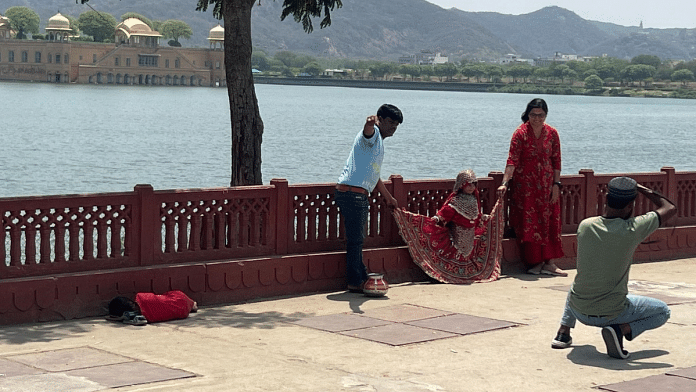Thank you dear subscribers, we are overwhelmed with your response.
Your Turn is a unique section from ThePrint featuring points of view from its subscribers. If you are a subscriber, have a point of view, please send it to us. If not, do subscribe here: https://theprint.in/subscribe/
The photograph above, taken at Jal Mahal in Jaipur, Rajasthan, captures a quiet but powerful reality. A young girl, dressed in vibrant traditional Rajasthani attire, smiles as her parents proudly pose beside her—confident, cared for, and clearly loved. Just a few feet away in the same frame, another child lies asleep on the pavement, barefoot, dusty, and alone. Two childhoods—one seemingly secure, the other surviving—coexisting in the same moment, yet worlds apart.
What separates them isn’t fate—it’s access. The child with her parents likely has food security, a roof over her head, access to clean water, and the promise of education. The other may have none of these. Early life access to basic needs like clean drinking water, adequate nutrition, supportive parenting, and education lays the foundation for a child’s future. Deprived of these, a child is more likely to face poor health, drop out of school, and remain trapped in the cycle of poverty.
Government Action: Bold Vision, Uneven Grounding
India has not been blind to this disparity. Major initiatives like the PM POSHAN Scheme (formerly the Mid-Day Meal Scheme), Jal Jeevan Mission, and Samagra Shiksha Abhiyan have been launched to provide children with nutritious food, drinking water, and inclusive schooling. Campaigns like Beti Bachao, Beti Padhao have brought gender equality into the national spotlight.
Yet, the challenges remain staggering. As per NFHS-5 (2019–21), 35.5% of Indian children under five are stunted, and 19.3% are wasted—signs of chronic and acute malnutrition. Despite the promise of “Har Ghar Jal” by 2024, only around 75% of rural households had functional tap connections as of early 2025. Teacher shortages, absenteeism, and infrastructure gaps persist across thousands of schools. The intent is noble, but execution is often patchy.
We Are 1.4 Billion. Can the Government Do It Alone ?
India’s vastness is both a resource and a responsibility. No government, however efficient, can transform the lives of 1.4 billion people in isolation. Public policy needs the backing of public participation. That means shifting from being passive beneficiaries to active partners in nation-building.
This photograph isn’t just about inequality—it’s about what we’ve normalised. We walk past children sleeping on pavements. We shake our heads at school dropout rates without asking what we can do. But India’s development can’t be left solely to budgets and bureaucrats. It demands citizen involvement at scale.
Educated but Underemployed: India’s Untapped Power
Here lies a powerful opportunity. India has over 3 crore unemployed graduates as per recent CMIE data. Many of them are aspirants waiting on competitive exams, job interviews, or the “right” opportunity. What if, in the meantime, they volunteered to teach?
Just an hour a day at a nearby government school could change the trajectory of dozens of children. Spoken English, basic math, digital skills, storytelling—volunteers can bring fresh energy and mentorship to classrooms that are otherwise overstretched.
Other countries have shown the impact of structured civic engagement. Finland integrates community interaction deeply into its school system, contributing to its world-leading education outcomes. Japan encourages school-based volunteering as a national ethos, building civic responsibility from a young age. Programs like Teach For America in the U.S. and Teach First in the U.K. have channelled young talent into classrooms, reducing educational inequity while also nurturing leadership skills in volunteers.
In India, Teach For India and similar fellowships are valuable, but limited in scale. What we need is a mass movement—made possible if every educated citizen sees volunteering not as charity, but as a civic duty.
Our Children, Our Future
The two children in the photo are not statistics—they are the face of India’s present and its future. One child may be headed for education and empowerment, the other for invisibility. But neither story is set in stone. Access can be created. Opportunity can be shared. And dignity can be restored—not just by policy, but by people.
As citizens, we must rise to fill the gap between government effort and ground reality. The path to a just, literate, and poverty-free India lies not just in economic growth, but in collective action.
The future is not something we inherit. It’s something we help build.
**Author**: Garimella SVSS Prasad
**Contact**: [+91-8595351169]
**Photograph**: © Garimella Prasad
These pieces are being published as they have been received – they have not been edited/fact-checked by ThePrint.



Very nice expression 👌👏👏